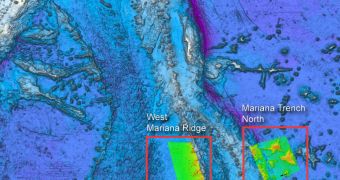A group of marine geophysicists at the University of New Hampshire, led by expert James Gardner, announces the discovery of several impressive bridges underneath the waters of the Pacific Ocean. The structures connect various sectors of the famous Mariana Trench.
The latter is the deepest underwater trench in the world, piercing Earth's crust to a depth of about 11 kilometers (6.8 miles). It is located to the south and east of the coasts of Japan and the Philippines, respectively, and it is already renowned for being the deepest place on Earth.
Now, researchers show that the Mariana Trench is also special for its exquisite seafloor features, which are unique at this point. The depths of the formation are spanned by at least four bridges, the research team uncovered during a recent investigation.
The underwater abyss formed at the location where the Pacific Plate dives under the Philippine Plate. Tectonic interplays lead to the sinking of Earth's crust to such depths. “It wasn't common knowledge that these bridges occurred at all,” Gardner explains.
“This is really the first time they've been mapped in any detail,” says the investigator, who was the one who made the discovery. He adds that the phenomenon is rare because a lot of factors are involved in making it a reality.
In order to understand it, one must understand that each of the two plates involved in creating the trench carries with it underwater mountains and hills, which are all heading towards the abyss. When a seamount enters the trench, its peak tips, and then begins to grind against the opposite wall.
For all intents and purposes, these peaks resemble bridges. The reason why their formation is uncommon is that not many seamounts exist on the seafloor around deep trenches, which makes the phenomenon rather rare.
Of the four underwater bridges discovered in the Mariana Trench, one rises about 2 kilometers (6,600 feet) above the abyss, and is about 75 kilometers (47 miles) long, LiveScience reports. Experts call it the Dutton Ridge. It was the first structure of its kind ever discovered, back in the 1980s.
“As the Pacific Plate gets thrust down underneath the Philippine Plate, it wouldn't be totally unexpected that you'd find these things bridging across the trench and being accreted to the inner wall,” Gardner says.
“I would certainly expect Dutton Ridge and the others to have different fauna and flora than the trench floor, because they stand about 2 kilometers [1.2 miles] higher. But the extreme depth would make it hard to monitor the biology or seafloor currents in the area,” the expert concludes.

 14 DAY TRIAL //
14 DAY TRIAL //